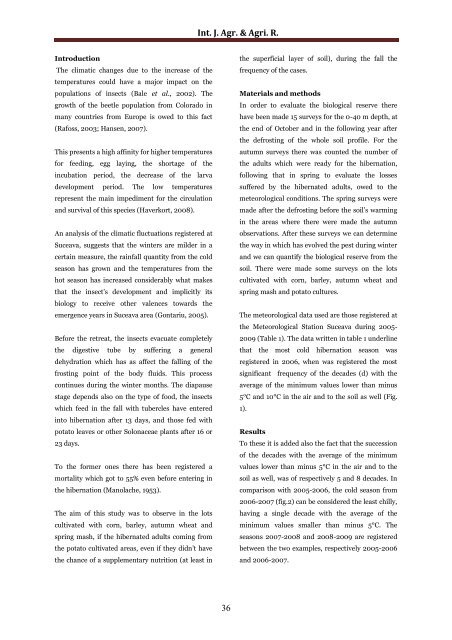The effects of the thermal and pluviometric regime over the adults reserve from the soil of the colorado beetle (Leptinotarsa decemlineata Say) in the climatic conditions from Suceava area
Abstract In our experiment we observe the autumn and spring surveys. After these surveys we can determine the way in which has evolved the pest during winter and we can quantify the biological reserve from the soil. There were made some surveys on the lots cultivated with corn, barley, autumn wheat and spring mash and potato cultures. The results of the surveys show that in the analyzed winters only 29% were registered significant losses of the hibernate adults. The homogeneity of the values could suggest that during the less cold winters, the biological reserve could be diminished with approximately half from the number of the hibernated adults from the potato cultivated field.
Abstract
In our experiment we observe the autumn and spring surveys. After these surveys we can determine the way in which has evolved the pest during winter and we can quantify the biological reserve from the soil. There were made some surveys on the lots cultivated with corn, barley, autumn wheat and spring mash and potato cultures. The results of the surveys show that in the analyzed winters only 29% were registered significant losses of the hibernate adults. The homogeneity of the values could suggest that during the less cold winters, the biological reserve could be diminished with approximately half from the number of the hibernated adults from the potato cultivated field.
Create successful ePaper yourself
Turn your PDF publications into a flip-book with our unique Google optimized e-Paper software.
Int. J. Agr. & Agri. R.<br />
Introduction<br />
<strong>The</strong> <strong>climatic</strong> changes due to <strong>the</strong> <strong>in</strong>crease <strong>of</strong> <strong>the</strong><br />
temperatures could have a major impact on <strong>the</strong><br />
populations <strong>of</strong> <strong>in</strong>sects (Bale et al., 2002). <strong>The</strong><br />
growth <strong>of</strong> <strong>the</strong> <strong>beetle</strong> population <strong>from</strong> Colorado <strong>in</strong><br />
many countries <strong>from</strong> Europe is owed to this fact<br />
(Rafoss, 2003; Hansen, 2007).<br />
This presents a high aff<strong>in</strong>ity for higher temperatures<br />
for feed<strong>in</strong>g, egg lay<strong>in</strong>g, <strong>the</strong> shortage <strong>of</strong> <strong>the</strong><br />
<strong>in</strong>cubation period, <strong>the</strong> decrease <strong>of</strong> <strong>the</strong> larva<br />
development period. <strong>The</strong> low temperatures<br />
represent <strong>the</strong> ma<strong>in</strong> impediment for <strong>the</strong> circulation<br />
<strong>and</strong> survival <strong>of</strong> this species (Haverkort, 2008).<br />
An analysis <strong>of</strong> <strong>the</strong> <strong>climatic</strong> fluctuations registered at<br />
<strong>Suceava</strong>, suggests that <strong>the</strong> w<strong>in</strong>ters are milder <strong>in</strong> a<br />
certa<strong>in</strong> measure, <strong>the</strong> ra<strong>in</strong>fall quantity <strong>from</strong> <strong>the</strong> cold<br />
season has grown <strong>and</strong> <strong>the</strong> temperatures <strong>from</strong> <strong>the</strong><br />
hot season has <strong>in</strong>creased considerably what makes<br />
that <strong>the</strong> <strong>in</strong>sect’s development <strong>and</strong> implicitly its<br />
biology to receive o<strong>the</strong>r valences towards <strong>the</strong><br />
emergence years <strong>in</strong> <strong>Suceava</strong> <strong>area</strong> (Gontariu, 2005).<br />
Before <strong>the</strong> retreat, <strong>the</strong> <strong>in</strong>sects evacuate completely<br />
<strong>the</strong> digestive tube by suffer<strong>in</strong>g a general<br />
dehydration which has as affect <strong>the</strong> fall<strong>in</strong>g <strong>of</strong> <strong>the</strong><br />
frost<strong>in</strong>g po<strong>in</strong>t <strong>of</strong> <strong>the</strong> body fluids. This process<br />
cont<strong>in</strong>ues dur<strong>in</strong>g <strong>the</strong> w<strong>in</strong>ter months. <strong>The</strong> diapause<br />
stage depends also on <strong>the</strong> type <strong>of</strong> food, <strong>the</strong> <strong>in</strong>sects<br />
which feed <strong>in</strong> <strong>the</strong> fall with tubercles have entered<br />
<strong>in</strong>to hibernation after 13 days, <strong>and</strong> those fed with<br />
potato leaves or o<strong>the</strong>r Solonaceae plants after 16 or<br />
23 days.<br />
To <strong>the</strong> former ones <strong>the</strong>re has been registered a<br />
mortality which got to 55% even before enter<strong>in</strong>g <strong>in</strong><br />
<strong>the</strong> hibernation (Manolache, 1953).<br />
<strong>The</strong> aim <strong>of</strong> this study was to observe <strong>in</strong> <strong>the</strong> lots<br />
cultivated with corn, barley, autumn wheat <strong>and</strong><br />
spr<strong>in</strong>g mash, if <strong>the</strong> hibernated <strong>adults</strong> com<strong>in</strong>g <strong>from</strong><br />
<strong>the</strong> potato cultivated <strong>area</strong>s, even if <strong>the</strong>y didn’t have<br />
<strong>the</strong> chance <strong>of</strong> a supplementary nutrition (at least <strong>in</strong><br />
<strong>the</strong> superficial layer <strong>of</strong> <strong>soil</strong>), dur<strong>in</strong>g <strong>the</strong> fall <strong>the</strong><br />
frequency <strong>of</strong> <strong>the</strong> cases.<br />
Materials <strong>and</strong> methods<br />
In order to evaluate <strong>the</strong> biological <strong>reserve</strong> <strong>the</strong>re<br />
have been made 15 surveys for <strong>the</strong> 0-40 m depth, at<br />
<strong>the</strong> end <strong>of</strong> October <strong>and</strong> <strong>in</strong> <strong>the</strong> follow<strong>in</strong>g year after<br />
<strong>the</strong> defrost<strong>in</strong>g <strong>of</strong> <strong>the</strong> whole <strong>soil</strong> pr<strong>of</strong>ile. For <strong>the</strong><br />
autumn surveys <strong>the</strong>re was counted <strong>the</strong> number <strong>of</strong><br />
<strong>the</strong> <strong>adults</strong> which were ready for <strong>the</strong> hibernation,<br />
follow<strong>in</strong>g that <strong>in</strong> spr<strong>in</strong>g to evaluate <strong>the</strong> losses<br />
suffered by <strong>the</strong> hibernated <strong>adults</strong>, owed to <strong>the</strong><br />
meteorological <strong>conditions</strong>. <strong>The</strong> spr<strong>in</strong>g surveys were<br />
made after <strong>the</strong> defrost<strong>in</strong>g before <strong>the</strong> <strong>soil</strong>’s warm<strong>in</strong>g<br />
<strong>in</strong> <strong>the</strong> <strong>area</strong>s where <strong>the</strong>re were made <strong>the</strong> autumn<br />
observations. After <strong>the</strong>se surveys we can determ<strong>in</strong>e<br />
<strong>the</strong> way <strong>in</strong> which has evolved <strong>the</strong> pest dur<strong>in</strong>g w<strong>in</strong>ter<br />
<strong>and</strong> we can quantify <strong>the</strong> biological <strong>reserve</strong> <strong>from</strong> <strong>the</strong><br />
<strong>soil</strong>. <strong>The</strong>re were made some surveys on <strong>the</strong> lots<br />
cultivated with corn, barley, autumn wheat <strong>and</strong><br />
spr<strong>in</strong>g mash <strong>and</strong> potato cultures.<br />
<strong>The</strong> meteorological data used are those registered at<br />
<strong>the</strong> Meteorological Station <strong>Suceava</strong> dur<strong>in</strong>g 2005-<br />
2009 (Table 1). <strong>The</strong> data written <strong>in</strong> table 1 underl<strong>in</strong>e<br />
that <strong>the</strong> most cold hibernation season was<br />
registered <strong>in</strong> 2006, when was registered <strong>the</strong> most<br />
significant frequency <strong>of</strong> <strong>the</strong> decades (d) with <strong>the</strong><br />
average <strong>of</strong> <strong>the</strong> m<strong>in</strong>imum values lower than m<strong>in</strong>us<br />
5°C <strong>and</strong> 10°C <strong>in</strong> <strong>the</strong> air <strong>and</strong> to <strong>the</strong> <strong>soil</strong> as well (Fig.<br />
1).<br />
Results<br />
To <strong>the</strong>se it is added also <strong>the</strong> fact that <strong>the</strong> succession<br />
<strong>of</strong> <strong>the</strong> decades with <strong>the</strong> average <strong>of</strong> <strong>the</strong> m<strong>in</strong>imum<br />
values lower than m<strong>in</strong>us 5°C <strong>in</strong> <strong>the</strong> air <strong>and</strong> to <strong>the</strong><br />
<strong>soil</strong> as well, was <strong>of</strong> respectively 5 <strong>and</strong> 8 decades. In<br />
comparison with 2005-2006, <strong>the</strong> cold season <strong>from</strong><br />
2006-2007 (fig.2) can be considered <strong>the</strong> least chilly,<br />
hav<strong>in</strong>g a s<strong>in</strong>gle decade with <strong>the</strong> average <strong>of</strong> <strong>the</strong><br />
m<strong>in</strong>imum values smaller than m<strong>in</strong>us 5°C. <strong>The</strong><br />
seasons 2007-2008 <strong>and</strong> 2008-2009 are registered<br />
between <strong>the</strong> two examples, respectively 2005-2006<br />
<strong>and</strong> 2006-2007.<br />
36





![Review on: impact of seed rates and method of sowing on yield and yield related traits of Teff [Eragrostis teff (Zucc.) Trotter] | IJAAR @yumpu](https://documents.yumpu.com/000/066/025/853/c0a2f1eefa2ed71422e741fbc2b37a5fd6200cb1/6b7767675149533469736965546e4c6a4e57325054773d3d/4f6e6531383245617a537a49397878747846574858513d3d.jpg?AWSAccessKeyId=AKIAICNEWSPSEKTJ5M3Q&Expires=1719133200&Signature=DWCYnPs5O3Frjx7kZ2yr%2FuF4LGw%3D)












